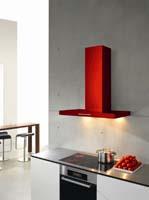Among domestic appliances, cooker hoods are often underestimated products – technically, they are perceived to be simple devices, resulting in a greater focus on attractive design. But a closer look at workmanship, quality and functionality is always worthwhile as differences can be considerable. Mercia de Jager, Miele Product Manager, offers a few pointers on what to look for when investing in a cooker hood.

“Double glazing, central heating and insulation all hinder the circulation of fresh air. In the kitchen cooking generates steam, grease and odours that have nowhere to go unless they are either extracted or recirculated,” explains de Jager. She says that this is especially compounded when taking into consideration the open-plan living trend – where kitchens are becoming a seamless part of the central living area. As a result cooker hoods are a vital part of any modern kitchen design.
“Although cooker hoods need to look good, there are several considerations above and beyond the aesthetic. Whilst design is important, it requires the combination of form and function to create a kitchen that is both beautiful and comfortable,” says de Jager. Here are the main things to look for:

What size?
The size or suction capacity of the hood usually depends on the size of the kitchen, the quantity of cooking done and the cooking method most often used, explains de Jager: “To calculate the output required, simply multiply the height, width and depth of the room in question, subtract 20% (for furniture) and multiply this figure by the number of air changes per hour (6 to 12 are recommended).
“Don’t forget to take your cooking habits into account too,” warns de Jager, “For anyone who regularly prepares food and has a small kitchen, the cookerhood should have a minimum capacity of between 300m3 to 400m3 per hour. For a family of three or four, with an average-sized kitchen, the model should have a capacity of around 400m3 to 500m3 per hour. For larger families and cooking enthusiasts who like to sample exotic recipes, the extractor should have a suction capacity of at least 600m3 per hour.”

Recirculation or extraction
De Jager explains the difference between recirculation and extraction extractor fans: “Recirculation hoods draw the air into the appliance through a charcoal filter to remove odours, grease and smoke from the air, before releasing the ‘clean’ air back into the kitchen. The filter needs to be replaced every year or so, to ensure optimum performance.” She says that the benefits of recirculation hoods include that they are generally more affordable than extraction hoods as no ducting is required, and that they can be installed virtually anywhere, which is great for small or awkwardly positioned kitchens where you can’t reach an outside wall with ducting. However, she notes that generally speaking, recirculation hoods are not as powerful as their extraction counterparts.

“Extraction hoods on the other hand, filter air with a metal filter grease trap before releasing it through an outside vent. Most top-end models boast metal grease filters with a quick-release mechanism, enabling them to be easily removed and cleaned by hand or in the dishwasher. These cooker hoods are exceptionally effective; however they do require access to the outside.
Different types of cooker hoods
There are three main types of cooker hoods, namely:
- The integrated hood: Ideal for small kitchens or kitchens with a complete integrated look – these hoods are built into a chimney breast or under a row of kitchen cabinets. They are specifically designed to fit into enclosed spaces and as a result are finished on the underside only – the only part that is visible once installed.

- The island hood: These hoods are designed for kitchens where the hob is positioned away from a wall in a central island. As such, they are finished on all four sides, as all are visible. Generally, they tend to be of a more modern style and are usually stainless in finish.
- The wall hood: By far the most common, these hoods are positioned against a wall, above the hob. They are finished on one side only and comprise mainly stainless steel, with some having an added element of glass for that “wow” factor.
How to differentiate good quality from bad
Even untrained consumers can tell mass-produced wares from quality goods if they know what to look for, says de Jager: “When looking for quality, a close inspection of the canopy is a good place to start – sheet metal joints with gaps and sharp edges are not a testimony to good workmanship. Wall and island canopies have to be carefully built using a sophisticated manual processes. A rectangular canopy has to be tangent-bent to shape. This is followed by carefully welding the corners before sanding and buffing the joint. The result is a pleasing and blemish-free surface.

The primary purpose of a cooker hood is to rid the kitchen of greasy vapours and unpleasant smells – a good quality hood should do this both efficiently and quietly, says de Jager: “To this end, high-quality hoods for example, contain encapsulated fans to reduce motor sound emissions. These motors are also powerful enough to overcome the counter pressure in long vent ducting or ducting with bends or obstacles. A further approach to reducing sound emissions is to deal with the unit acting as a resonating body. Miele does this by lining canopies and chimneys with 3mm mats, which suppress vibrations and prevent these components acting as sounding boards.”
Other features to look out for
Aside from quality and performance, there are a whole host of other bells and whistles that differentiate top-end extractor fans from the rest, says de Jager. These include:
- Easy operation: Fully electronic controls and LED lights are always a plus.
- Feature lighting: Top-end cooker hoods should combine traditional halogen downlighters with feature lighting for a stunning kitchen look. Models boast different colored lights that can be used as ambient kitchen lighting, while others feature a dimmer switch for the halogen lights, which allow you to set the ambience and atmosphere in your kitchen.
- Colour-coded hoods: Colour-coded extractor fans, allow you to personalise the colour of the extractor to suit your kitchen’s specific décor and colour palette.
- Smart hoods: The latest in cookerhood technology includes hoods that create a dialogue with the hobs below them. De Jager explains: “Whether the saucepans are boiling, simmering or frying, the hood automatically detects and adapts its settings to the type of cooking taking place on the hob. The system allows the user to give their undivided attention to the ingredients they’re preparing and in the process helps create an altogether cleaner and cooler kitchen environment. To ensure efficiency, the hood adjusts automatically with changes in the cooking process – you turn up the hob and the hood reacts accordingly.”
- Environmentally friendly: With the ever-increasing price of electricity, along with a global drive to be more environmentally responsible, more and more consumers are looking for appliances that do more, while using less electricity. As such, low consumption is a key issue in domestic appliances. Over and above this, appliances should built to last for up to 20 years, which in itself reduces their carbon footprint. – Antonella Desi
Pictures courtesy of Miele.
Readers' CommentsHave a comment about this article? Email us now.








